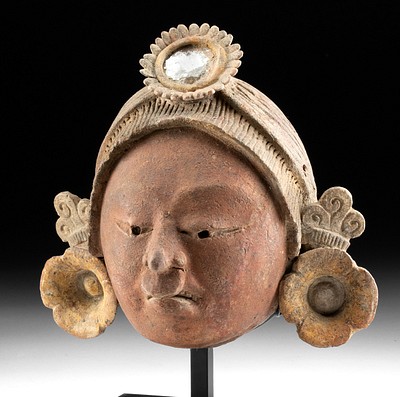Egyptian Ptolemaic Cartonnage Child Sarcophagus Mask
Lot 1a
About Seller
Artemis Fine Arts
686 S Taylor Ave, Ste 106
Louisville, CO 80027
United States
Selling antiquities, ancient and ethnographic art online since 1993, Artemis Gallery specializes in Classical Antiquities (Egyptian, Greek, Roman, Near Eastern), Asian, Pre-Columbian, African / Tribal / Oceanographic art. Our extensive inventory includes pottery, stone, metal, wood, glass and textil...Read more
Categories
Estimate:
$9,000 - $13,000
Absentee vs Live bid
Two ways to bid:
- Leave a max absentee bid and the platform will bid on your behalf up to your maximum bid during the live auction.
- Bid live during the auction and your bids will be submitted real-time to the auctioneer.
Bid Increments
| Price | Bid Increment |
|---|---|
| $0 | $25 |
| $300 | $50 |
| $1,000 | $100 |
| $2,000 | $250 |
| $5,000 | $500 |
| $10,000 | $1,000 |
| $20,000 | $2,500 |
| $50,000 | $5,000 |
| $100,000 | $10,000 |
| $200,000 | $20,000 |
About Auction
By Artemis Fine Arts
Jul 14, 2022
Set Reminder
2022-07-14 10:00:00
2022-07-14 10:00:00
America/New_York
Bidsquare
Bidsquare : Exceptional Antiquities Ethnographica Fine Art
https://www.bidsquare.com/auctions/artemis-gallery/exceptional-antiquities-ethnographica-fine-art-9692
Museum-worthy examples of classical antiquities (Egyptian, Greek, Roman, Near Eastern), Viking, Far East / Asian, Pre-Columbian, African / Tribal, Oceanic, Native American, Spanish Colonial, Fossils, Ancient Jewelry, Fine / Visual Arts, so much more! Artemis Fine Arts info@artemisfinearts.com
Museum-worthy examples of classical antiquities (Egyptian, Greek, Roman, Near Eastern), Viking, Far East / Asian, Pre-Columbian, African / Tribal, Oceanic, Native American, Spanish Colonial, Fossils, Ancient Jewelry, Fine / Visual Arts, so much more! Artemis Fine Arts info@artemisfinearts.com
- Lot Description
Egypt, Ptolemaic period, ca. 332 to 30 BCE. Beautifully crafted from imported wood layered with gesso and linen, a stunning mummy mask meant for a male child with a stylized, theatrical countenance. A slender pair of arms cross over the chest, each elongated finger with an incised nail bed which perhaps held inlaid ornamentation. A minimalist wesekh collar droops between a pair of lotus blossoms, with similar linear and stippled motifs in red, white, and green detailing much of the torso and brow line. The visage is comprised of almond-shaped eyes outlined in black, a prominent nose, full lips and cheeks, cupped ears, and painted eyebrows atop a smooth forehead. Five raised bulbs adorn the crest of the brow, leading back towards zigzag motifs on an orange ground and black-and-white triangles on the verso. Custom fabric-lined mount and wooden display stand included. Size: 12" W x 16" H (30.5 cm x 40.6 cm); 17" H (43.2 cm) on included custom stand.
The helmet mask, which had fallen out of favor in earlier dynastic periods, saw a resurgence of popularity during the era of Greek rule. The masks would have been placed over the head of a mummy, with the rest of the body adorned with separate cartonnage pieces. However, renowned Egyptologist Dr. Salima Ikram explains how, "as the Ptolemaic Period progressed, these separate cartonnage pieces had a tendency to join together, producing a single sheet over the front of the mummy" (Ikram, Salima, and Aidan Dodson. The Mummy in Ancient Egypt: Equipping the Dead for Eternity. Thames and Hudson, London, 1998, p. 187). This example is one that appears to have been part of a larger, single-sheet construction based on the uneven way the painted details seem to end as well as the jaggedness of the bottom periphery, seemingly cut away from the lower portion in a crude and unconscientious operation.
Given the size of both the sarcophagus mask itself as well as the interior head cavity, this was likely made for a child from a prominent, upper-class family. While gilding was a popular decorative element for later Egyptian sarcophagi, embellishing with gold was reserved solely for those who could afford such luxuries. The craftsmanship of the construction, intricate yet simple painted adornments, and inlaid fingernails suggest an abundance of wealth, with rich pigmentation hues of crimson, jet, emerald, and pearl helping to reinforce this notion.
Cf. The British Museum, museum number EA50668
Provenance: private Annapolis, Maryland, USA collection, acquired at auction from Artemis Gallery, June 20, 2018, lot 8; ex-private Cypress, Texas, USA collection
All items legal to buy/sell under U.S. Statute covering cultural patrimony Code 2600, CHAPTER 14, and are guaranteed to be as described or your money back.
A Certificate of Authenticity will accompany all winning bids.
PLEASE NOTE: Due to recent increases of shipments being seized by Australian & German customs (even for items with pre-UNESCO provenance), we will no longer ship most antiquities and ancient Chinese art to Australia & Germany. For categories of items that are acceptable to ship to Australia or Germany, please contact us directly or work with your local customs brokerage firm.
Display stands not described as included/custom in the item description are for photography purposes only and will not be included with the item upon shipping.
#172649This is a section of a larger cartonnage mummy cover. Hands, lower body, shoulders, and back of head all repaired from multiple pieces with some losses, overpainting, and areas of restoration along break lines; "gilding" on head and arms is modern brass leaf. Surface wear commensurate with age and use as shown, nicks and chips to face head, and lower periphery, with fading, staining, and discoloration on inside and outside, otherwise excellent. Light earthen deposits throughout, and great remains of pigmentation across exterior.Condition
- Shipping Info
-
All shipping is handled in-house for your convenience. Your invoice from Artemis Gallery will include shipping calculation instructions. If in doubt, please inquire BEFORE bidding for estimated shipping costs for individual items.
-
- Buyer's Premium



 EUR
EUR CAD
CAD AUD
AUD GBP
GBP MXN
MXN HKD
HKD CNY
CNY MYR
MYR SEK
SEK SGD
SGD CHF
CHF THB
THB














